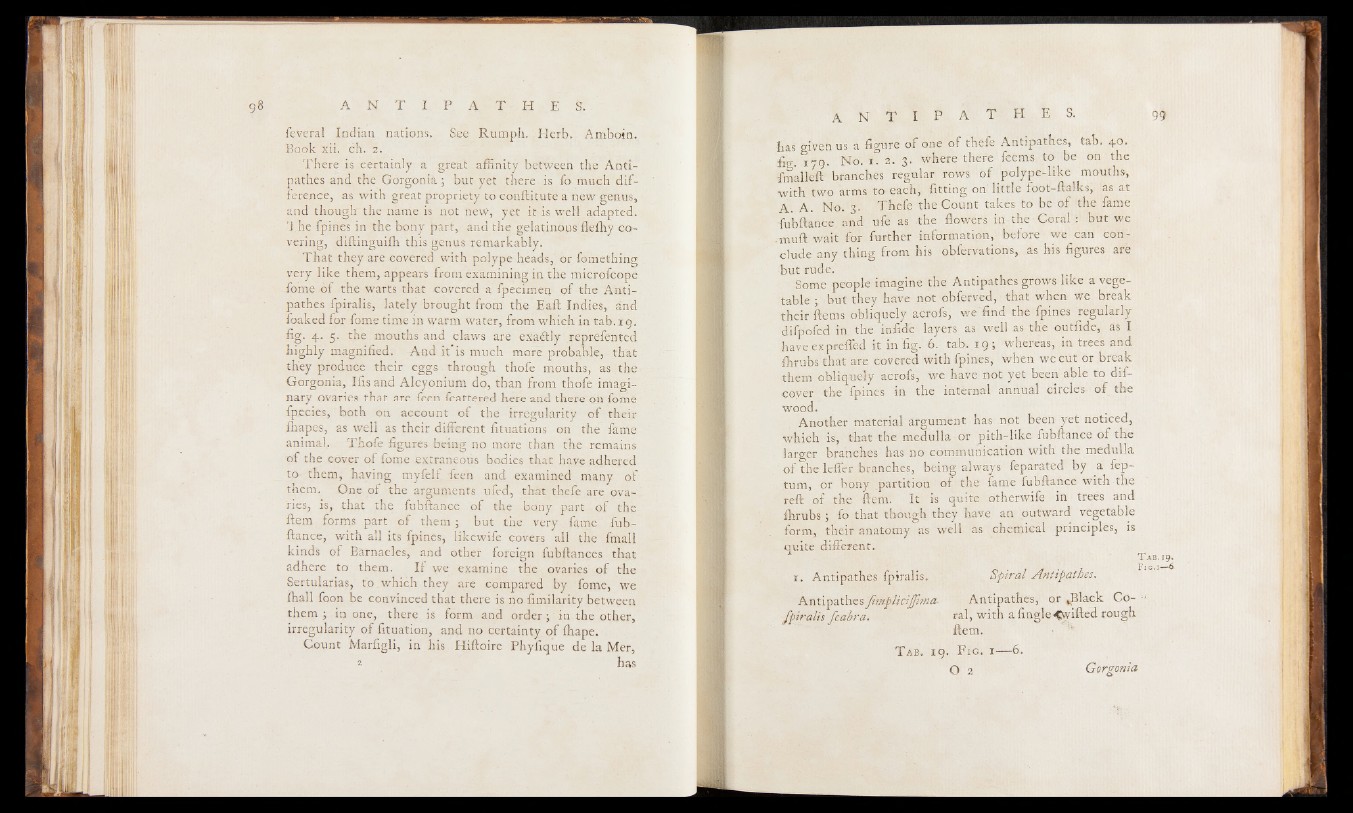
feveral Indian nations. See Rumph. Herb. Amboin.
Book xii. ch. z.
There is certainly a great affinity between the Anti-
pathes and the Gorgonia; but yet there is fo much difference,
as with great propriety to conftitute a new genus,
and though the name is not new, yet it is well adapted.
The fpines in the bony part, and the gelatinous fleffiy covering,
diftinguifh this genus remarkably.
That they are covered with polype heads, or fomething
very like them, appears from examining in the microfcope
forne of the warts that covered a fpecimen of the Anti-
pathes fpiralis, lately brought from the Eaft Indies, and
foaked for fome time in warm water, from which in tab. 19.
fig. 4. 5. the mouths and claws are exactly reprefented
highly magnified. And it"is much more probable, that
they produce their eggs through thofe mouths, as the
Gorgonia, Ifis and Alcyonium do, than from thofe imaginary
ovaries that are feen fcattered here and there oil fome
fpecies, both on account of the irregularity of their
ffiapes, as well as their different fituations on thefame
animal, Thofe figures being no more than the remains
of the cover of fome extraneous bodies that have adhered
to them, having myfelf feen and examined many of
them. One of the arguments ufed, that thefe are ovaries,
is, that the fubftance of the bony part of the
ftem forms part of them; but the very fame fubftance,
with all its fpines, likewife covers all the fmall
kind's of Barnacles, and other foreign fubftances that
adhere to them. I f we examine the ovaries of the
Sertularias, to which they are compared by fome, we
ffiall foon be convinced that there is no fimilarity between
them ; in one, there is form and order; in the other,
irregularity of fituation, and no certainty of ffiape.
Count Marfigli, in his Hiftoire Phyfique de la Mer,
2 has
has given us a figure of one of thefe Antipathes, tab. 40.
fig. 179. No. 1. 2. 3. where there feems to be on the
fmalleft branches regular rows of polype-like mouths,
with two arms to each, fitting on little foot-ftalks, as at
A. A. No. 3. Thefe the Count takes to be of the fame
fubftance and ufe as the flower's in the-Coral : but we
• muft wait for further information, before we can conclude
any thing from his observations, as his figures are
but rude.'
Some people imagine the Antipathes grows like a vegetable
; but they have not obferved, that when we break
their ftems obliquely acrofs, we'find the fpines regularly
difpofed in the infide layers as well as the outfide, as I
haveexpreffed it in fig. 6. tab, 19; whereas, in trees and
fhrubs that are covered with fpines, when we cut or break
them obliquely acrofs, we have not yet been able to dif-
cover the fpines in the internal annual circles of the
wood.
Another material argument has not been yet noticed,
which is, that the medulla or pith-like fubftance of the
larger branches has no communication with the medulla
of the leffer branches, being always feparated by a fep-
tum, or bony partition of the fame fubftance with the
reft of the ftem. It is quite otherwife in trees and
fhrubs; fo that though they have an outward vegetable
form, their anatomy as well as chemical principles, is
quite different.
^ Ti
1. Antipathes fpiralis. Spiral Antipathes.
Ks\X.\pa.xht.s'JimpliciJfitna Antipathes, or »Black Co-
fpiralis fcabra; ral, with a fingleSwifted rough
ftem.
T ab. 19. F ig. i— 6.
O 2 Gorgonia